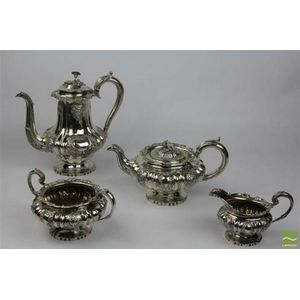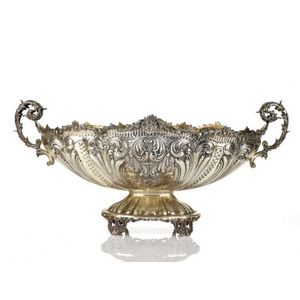Rebecca Emes & Edward Barnard Silver Tea/Coffee Set
You must be a subscriber, and be logged in to view price and dealer details.
Subscribe Now to view actual auction price for this item
When you subscribe, you have the option of setting the currency in which to display prices to $Au, $US, $NZ or Stg.
- Sterling Silver - Sterling silver is a mixture of 92.5% pure silver and 7.5% of another metal, usually copper. Fine silver is 99.9% pure silver, and is relatively soft and the addition of the very small amount of copper gives the metal enough strength and hardness to be worked into jewellery, decorative and household objects.
- Circa - A Latin term meaning 'about', often used in the antique trade to give an approximate date for the piece, usually considered to be five years on either side of the circa year. Thus, circa 1900 means the piece was made about 1900, probably between 1895 and 1905. The expression is sometimes abbreviated to c.1900.
- George Iv - George IV (1762 ? 1830) was king of the United Kingdom of Great Britain and Ireland and king of Hanover from 1820, until his own death in 1830. From 1811 until his accession in 1820, he served as Prince Regent during his father's final mental illness.
In English furniture design, his reign from 1811 to 1830 is known as the Regency period. - Acanthus - A stylized leaf motif, one of the primary decorative elements of classical Greek and Roman architecture, derived from the genus of flowering plants in the family Acanthaceae, native to tropical and subtropical regions of the Mediterranean area. It is a common element in classical Greek and Roman design, and is often seen in Corinthian and Composite order columns and used as a decorative element in English, European and Australian furniture, particularly on the curve of a leg, and as decoration for a corbel.
- Finial - An architectural decoration, found on the upper parts of of an object. On furniture they are usually found on pediments, canopies and shelf supports. On smaller ceramic or silver items, such as spoons, they may decorate the top of the item itself, or the lid or cover where they provide a useful handle for removal.
Finials have a variety of shapes and forms. They may be urn-shaped, baluster shaped round or spiral, but usually taper into an upper point. Many real life shapes may also be used as finials, such as pineapples, berries, pinecones, buds, lotus and acorns. Sometimes animals such as a lion are depicted, or fish and dolphins.
This item has been included into following indexes:
- Barnard , Edward and John (London) - silver, maker or retailer 209
- coffee sets/services - silver items 444
-
tea sets/services
- silver, four piece 317
- silver, George III 109
- silver, George IV 72
- silver, Georgian 143
Visually similar items

George IV sterling silver four piece tea & coffee set consisting of tea pot, coffee pot, sugar bowl & creamer, each decorated with embossed floral panels, the pots with flower shaped finials and leaf capped handles with small ivory insulators, London, coff

Ettore Leguti via Borromei, Milan c.1975 centrepiece of lobed oval form, the lobes with floral scrollwork, foliate scroll handles raised on an oval foot and four pierced foliate feet, engraved with the words 'Cesselato a mano, AGMA', 800 standard silver, w

Fine William IV sterling silver teaset, by Edward, Edward Jnr, William & John Barnard, of compressed melon form, the collar and foot of the teapot finely chased with rocaille, with floral knob and acanthus capped handle, London c1831. Weight: 1.573kg. Cond

An Italian late-19th century four piece silver tea service C. 1890, stamped 800 with wrythen twist bodies, dragon spouts, wooden scroll handles. Floral finials and scroll legs. Total weight 2316g. Height 22 cm.
